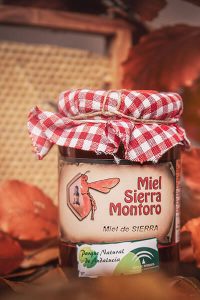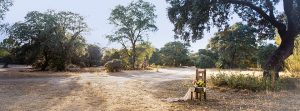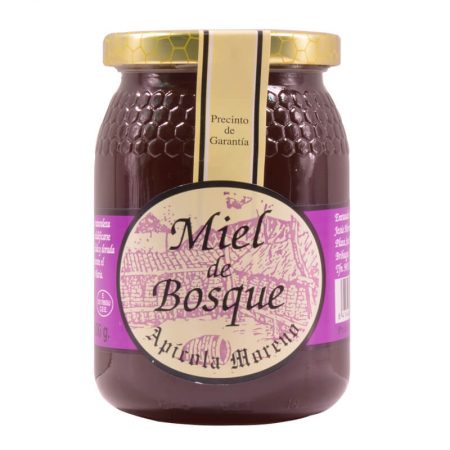Forest honey is a natural product that is elaborated in the stomach of honeybees from nectar of flowers from mountains and secretions of trees of the forest typical to the region. A honey that is slightly sweet and very rich in minerals, which you will love!

Best selection of forest honey of the highest quality from Spanish beekeepers.
Index:
|
Summary: Forest honey is a honey with a powerful flavour and very rich in minerals. All our honeys come from Spanish beekeepers committed to quality. It is also available in our shop in Las Rozas de Madrid.
Related articles: Raw unpasteurised honey. The 5 best honeys of Spain.
1. Our Forest Honey
Firstly, we show you the most important characteristics of honey of the forest:
a) Color
This honey has a dark color, almost black when the honey is liquid. When crystallized, it acquires brown or greyish brown shades.

Photo 1: Forest honey colours
b) Aroma
The aroma of this forest honey is very intense and persistent, especially in the retronasal, and reminds the deciduous forests in autumn, humus and mushrooms with light touches of liquorice and mint. Furthermore, when tasting it, salty notes and marked bitter components can be appreciated, with greater or lesser intensity depending on the origin of the mielatos.
Video 1: Forests of Spain
In this video we can also see some of the forests in Spain where forest and mountain honeys are extracted.
c) Sources of origin
A honey with different floral and arboreal sources from the forests and mountains of Spain. Although heather, holm oak and oak usually abound. It may also contain some rosemary, thyme and blackberry.
d) Harvesting
This honey is harvested at the end of summer, mainly in August and September. This is when the plants release the greatest amount of mielatos.
e) Pollen
In order for it to be forest honey, there must be no or very little cultivated pollen. Pollen of Fabaceae, Cistaceae, some labiatae, often heather and bramble are also present. In humid areas the presence of DEH (algae and fungi, honeydew elements); in dry areas these DEH disappear.
f) Conventional or ecological
Currently we do not have any beekeepers who supply us with honey from the organic forest, so we only have honey from the conventional forest, i.e. not organic.

Photo 1: Honey Sierra de Montoro
g) Target population
Furthermore, you should not feed honey to infants under 1 year olf. In this case, it is recommended that you ask your doctor for advice.
h) Gift of nature
In addition, honey is a gift of nature that we obtain from nature without any living being suffering.
i) Support for the rural environment
Finally, these honeys come also from beekeepers who create employment and wealth in rural areas. Likewise, our shop has also been created with the aim of promoting the Spanish rural environment.
“A honey with hints of malt that will not leave you indifferent.
2. Benefits and properties
Forest honey provides many health benefits. Its benefits, like other quality honey, are due to two reasons. Firstly, honey has a very low water concentration, and also has enzymes. Secondly, honey has many components from forest flowers and tree mielatos.
Myelates that provide a large amount of minerals can be demonstrated by their high electrical conductivity. Furthermore, these minerals are going to be very beneficial for our health and each one of them is going to bring something good to our body. Minerals such as iron.
In short, compiling information from the experience of doctors, beekeepers and popular wisdom, we have found the following scientific article. Firstly, this article has been published in a Chinese journal on chemical and pharmaceutical research and was written by scientists Satarupa and Subha. Therefore, here we have found the following information about the positive effects of such honey.
- Muscle fatigue: helps reduce muscle fatigue. On the one hand, the glucose in honey provides immediate energy to the body, thus reducing muscle fatigue. At the same time, honey fructose provides energy that is released more slowly. for this reason, honey is so beneficial to athletes.
- Boosts the immune system
- Promotes digestion
- Rich in antioxidants. The honey of the forest is rich in antioxidants, but this wealth depends on the floral origin of this honey. In addition, forest honey has more antioxidants than clear honeys.
- Wound treatment: Honey has been used for millennia to treat wounds, due to its bactericidal and antiviral capacity. Certainly, one of its reasons is its low water content and its maximum hydrogen peroxides.
In summary, we want to emphasize that here we are talking about popular experiences and knowledge. Since properties can only be assured in medicines and honey is not a medicine.
a) High conductivity
The high conductivity of this honey shows that it is very rich in minerals such as iron. Iron is very necessary for people suffering from anaemia.
To sum up, we would like to emphasize that we are talking about experiences, popular knowledge and scientific research. Therefore, if you have a health problem, we recommend you to visit your doctor.
b) Contraindications
People suffering from allergies should be careful when using this honey for the first time. Also, this natural product should not be abused, especially by people seeking to lose weight.
Also, people with pollen allergy should be careful with its consumption. In this case, ask your doctor.
“Highly regarded by previous generations”.
3. Recommendations
Forest honey, like dark honey, is a less sweet honey than the rest, so it is ideal for people looking for more powerful flavors and less sweet.
Delicious on toasts, biscuits, coffee and tea. Furthermore, in the preparation of dishes, this type of honey is recommended for making and pairing cold creams, red fruit sauces and chocolate desserts. Likewise, it is also ideal to combine with spicy dishes.

4. Indications
The crystallization of raw forest honey is usually very slow, and once crystallized can have both fine and coarse crystallization. As a result, it is one of the honeys that will almost always remain liquid.
In addition, the food sources that a forest provides for bees are not the same throughout the year. Certainly, each forest is not the same in Spain and the rest of Europe, so we will find noticeable differences each year of this type of honey and in each geographical origin.
“Sourced from the most unique forests in Spain”.

Photo 3: Forest honey of Apícola Moreno
5. Origin
Moreover, we obtain our raw honey from two beekeepers:
Beekeeper |
Location |
Characteristics |
| Apícola Moreno | Brihuega, Guadalajara | No organic |
| Adelheid | Germany | No organic |
| Las Obreras de Aliste | Zamora | No organic |
Table 1: Different beekeepers we work with.
In short, the origin of forest honey can vary quite a bit from one year to the next, because our beekeepers can place the hives in different parts of the forest. There can also be significant variations in flora throughout the year.
6. Frequently asked questions
In addition, these are the questions we are often asked:
-
Is this honey crystallised?
This is one of the honeys that takes longer to crystallise, so it will probably be liquid.
-
Is it good for people with anaemia?
However, this honey is rich in minerals and has a positive effect on people suffering from anaemia.
-
Which honeys are similar to forest honey?
Other honeys similar to forest honey are mountain, heather, oak and chestnut honey.
-
What are the differences between forest honey and mountain honey?
In Spain, there is usually little difference between the two honeys.
7. More information
Finally, we indicate the chemical and physical parameters that a forest honey must pass.
Chemical parameters |
||
| Colour (mm Pfund) Maximum 90 | Humidity (%). Max. 18 | Fructose + glucose: Minimum 45 |
| Sucrose: Maximum 5 | Electrical conductivity (mS/cm): minimum 0.7 to 0.9 | Free acidity (meq/kg): Maximum 50 |
| HMF (mg/Kg = ppm): Maximum 40 | Diastasases (Schade Units): Minimum 8 | Special parameters (F/G index): Minimum 1.5 |
Table 2: Directive 110/2001 EC, RD 1049/2003 in Spain
Source:
Fundación del corazón https://fundaciondelcorazon.com/






